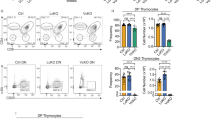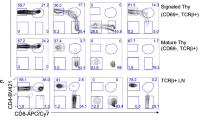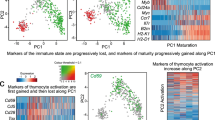Abstract
T cell antigen receptor (TCR) signaling in CD4+CD8+ double-positive thymocytes determines cell survival and lineage commitment, but the genetic and molecular basis of this process is poorly defined. To address this issue, we used ethylnitrosourea mutagenesis to identify a previously unknown T lineage–specific gene, Themis, which is critical for the completion of positive selection. Themis contains a tandem repeat of a unique globular domain (called 'CABIT' here) that includes a cysteine motif that defines a family of five uncharacterized vertebrate proteins with orthologs in most animal species. Themis-deficient thymocytes showed no substantial impairment in early TCR signaling but did show altered expression of genes involved in the cell cycle and survival before and during positive selection. Our data suggest a unique function for Themis in sustaining positive selection.
This is a preview of subscription content, access via your institution
Access options
Subscribe to this journal
Receive 12 print issues and online access
$209.00 per year
only $17.42 per issue
Buy this article
- Purchase on Springer Link
- Instant access to full article PDF
Prices may be subject to local taxes which are calculated during checkout







Similar content being viewed by others
Accession codes
Change history
19 August 2009
NOTE: In the version of this article initially published, the top right graph in Fig. 7b is incorrect. The error has been corrected in the HTML and PDF versions of the article.
References
He, X. et al. The zinc finger transcription factor Th-POK regulates CD4 versus CD8 T-cell lineage commitment. Nature 433, 826–833 (2005).
Hughes, P., Bouillet, P. & Strasser, A. Role of Bim and other Bcl-2 family members in autoimmune and degenerative diseases. Curr. Dir. Autoimmun. 9, 74–94 (2006).
Mitchell, B.S. & Kelley, W.N. Purinogenic immunodeficiency diseases: clinical features and molecular mechanisms. Ann. Intern. Med. 92, 826–831 (1980).
Siggs, O.M. et al. Opposing functions of the T cell receptor kinase ZAP-70 in immunity and tolerance differentially titrate in response to nucleotide substitutions. Immunity 27, 912–926 (2007).
Taniuchi, I. & Littman, D.R. Epigenetic gene silencing by Runx proteins. Oncogene 23, 4341–4345 (2004).
Weerkamp, F., van Dongen, J.J. & Staal, F.J. Notch and Wnt signaling in T-lymphocyte development and acute lymphoblastic leukemia. Leukemia 20, 1197–1205 (2006).
Germain, R.N. T-cell development and the CD4–CD8 lineage decision. Nat. Rev. Immunol. 2, 309–322 (2002).
Hernandez-Hoyos, G., Sohn, S.J., Rothenberg, E.V. & Alberola-Ila, J. Lck activity controls CD4/CD8 T cell lineage commitment. Immunity 12, 313–322 (2000).
Kappes, D.J. & He, X. CD4–CD8 lineage commitment: an inside view. Nat. Immunol. 6, 761–766 (2005).
Vinuesa, C.G. & Goodnow, C.C. Illuminating autoimmune regulators through controlled variation of the mouse genome sequence. Immunity 20, 669–679 (2004).
Terrence, K., Pavlovich, C.P., Matechak, E.O. & Fowlkes, B.J. Premature expression of T cell receptor (TCR)αβ suppresses TCRγδ gene rearrangement but permits development of δγ lineage T cells. J. Exp. Med. 192, 537–548 (2000).
Jimi, E., Strickland, I., Voll, R.E., Long, M. & Ghosh, S. Differential role of the transcription factor NF-κB in selection and survival of CD4+ and CD8+ thymocytes. Immunity 29, 523–537 (2008).
Kisielow, P., Bluthmann, H., Staerz, U.D., Steinmetz, M. & von Boehmer, H. Tolerance in T-cell-receptor transgenic mice involves deletion of nonmature CD4+8+ thymocytes. Nature 333, 742–746 (1988).
Woodland, D., Happ, M.P., Bill, J. & Palmer, E. Requirement for cotolerogenic gene products in the clonal deletion of I-E reactive T cells. Science 247, 964–967 (1990).
Cook, M.C., Vinuesa, C.G. & Goodnow, C.C. ENU-mutagenesis: insight into immune function and pathology. Curr. Opin. Immunol. 18, 627–633 (2006).
Lesourne, R. Themis, a T cell–specific protein important for late thymocyte development. Nat. Immunol. advance online publication doi:10.1038/ni1768 (13 July 2009).
Fu, G. et al. Themis controls thymocyte selection through regulation of T cell antigen receptor–mediated signaling. Nat. Immunol. advance online publication doi:10.1038/ni1766 (13 July 2009).
Fontenot, J.D., Rasmussen, J.P., Gavin, M.A. & Rudensky, A.Y. A function for interleukin 2 in Foxp3-expressing regulatory T cells. Nat. Immunol. 6, 1142–1151 (2005).
Hill, J.A. et al. Foxp3 transcription-factor-dependent and -independent regulation of the regulatory T cell transcriptional signature. Immunity 27, 786–800 (2007).
Marson, A. et al. Foxp3 occupancy and regulation of key target genes during T-cell stimulation. Nature 445, 931–935 (2007).
Burack, W.R., Cheng, A.M. & Shaw, A.S. Scaffolds, adaptors and linkers of TCR signaling: theory and practice. Curr. Opin. Immunol. 14, 312–316 (2002).
Cary, L.A. & Guan, J.L. Focal adhesion kinase in integrin-mediated signaling. Front. Biosci. 4, D102–D113 (1999).
Margolis, B. & Skolnik, E.Y. Activation of Ras by receptor tyrosine kinases. J. Am. Soc. Nephrol. 5, 1288–1299 (1994).
Lucas, B. & Germain, R.N. Unexpectedly complex regulation of CD4/CD8 coreceptor expression supports a revised model for CD4+CD8+ thymocyte differentiation. Immunity 5, 461–477 (1996).
Liston, A., Lesage, S., Gray, D.H., Boyd, R.L. & Goodnow, C.C. Genetic lesions in T-cell tolerance and thresholds for autoimmunity. Immunol. Rev. 204, 87–101 (2005).
Tsukamoto, H. et al. B-Raf-mediated signaling pathway regulates T cell development. Eur. J. Immunol. 38, 518–527 (2008).
Geiman, T.M. & Muegge, K. Lsh, an SNF2/helicase family member, is required for proliferation of mature T lymphocytes. Proc. Natl. Acad. Sci. USA 97, 4772–4777 (2000).
Okada, H. et al. Survivin loss in thymocytes triggers p53-mediated growth arrest and p53-independent cell death. J. Exp. Med. 199, 399–410 (2004).
Xing, Z., Conway, E.M., Kang, C. & Winoto, A. Essential role of survivin, an inhibitor of apoptosis protein, in T cell development, maturation, and homeostasis. J. Exp. Med. 199, 69–80 (2004).
Bensinger, S.J. et al. LXR signaling couples sterol metabolism to proliferation in the acquired immune response. Cell 134, 97–111 (2008).
Gallo, E.M. et al. Calcineurin sets the bandwidth for discrimination of signals during thymocyte development. Nature 450, 731–735 (2007).
Lee, M.S., Hanspers, K., Barker, C.S., Korn, A.P. & McCune, J.M. Gene expression profiles during human CD4+ T cell differentiation. Int. Immunol. 16, 1109–1124 (2004).
Kose, H. et al. Maturational arrest of thymocyte development is caused by a deletion in the receptor-like protein tyrosine phosphatase κ gene in LEC rats. Genomics 89, 673–677 (2007).
Asano, A., Tsubomatsu, K., Jung, C.G., Sasaki, N. & Agui, T. A deletion mutation of the protein tyrosine phosphatase κ (Ptprk) gene is responsible for T-helper immunodeficiency (thid) in the LEC rat. Mamm. Genome 18, 779–786 (2007).
Flavell, J.R. et al. Down-regulation of the TGF-β target gene, PTPRK, by the Epstein-Barr virus encoded EBNA1 contributes to the growth and survival of Hodgkin lymphoma cells. Blood 111, 292–301 (2008).
Nakamura, M. et al. Novel tumor suppressor loci on 6q22–23 in primary central nervous system lymphomas. Cancer Res. 63, 737–741 (2003).
Wang, S.E., Wu, F.Y., Shin, I., Qu, S. & Arteaga, C.L. Transforming growth factor β (TGF-β)-Smad target gene protein tyrosine phosphatase receptor type κ is required for TGF-β function. Mol. Cell. Biol. 25, 4703–4715 (2005).
Yang, Y. et al. Transforming growth factor-β1 inhibits human keratinocyte proliferation by upregulation of a receptor-type tyrosine phosphatase R-PTP-κ gene expression. Biochem. Biophys. Res. Commun. 228, 807–812 (1996).
Treeck, O. et al. Detection of increased icb-1 transcript levels in maturing HL-60 cells: a novel marker for granulocytic and monocytic in vitro differentiation. Leuk. Res. 26, 765–769 (2002).
Treeck, O., Kindzorra, I., Pauser, K., Treeck, L. & Ortmann, O. Expression of Icb-1 gene is interferon-γ inducible in breast and ovarian cancer cell lines and affects the IFN γ-response of SK-OV-3 ovarian cancer cells. Cytokine 32, 137–142 (2005).
Jun, J.E. et al. Identifying the MAGUK protein Carma-1 as a central regulator of humoral immune responses and atopy by genome-wide mouse mutagenesis. Immunity 18, 751–762 (2003).
Ho, W.Y., Cooke, M.P., Goodnow, C.C. & Davis, M.M. Resting and anergic B cells are defective in CD28-dependent costimulation of naive CD4+ T cells. J. Exp. Med. 179, 1539–1549 (1994).
Tanchot, C., Barber, D.L., Chiodetti, L. & Schwartz, R.H. Adaptive tolerance of CD4+ T cells in vivo: multiple thresholds in response to a constant level of antigen presentation. J. Immunol. 167, 2030–2039 (2001).
Huesmann, M., Scott, B., Kisielow, P. & von Boehmer, H. Kinetics and efficacy of positive selection in the thymus of normal and T cell receptor transgenic mice. Cell 66, 533–540 (1991).
Silver, K.L. et al. MyD88-dependent autoimmune disease in Lyn-deficient mice. Eur. J. Immunol. 37, 2734–2743 (2007).
Cornall, R.J. et al. Polygenic autoimmune traits: Lyn, CD22, and SHP-1 are limiting elements of a biochemical pathway regulating BCR signalling and selection. Immunity 8, 497–508 (1998).
Wan, F. et al. Ribosomal protein S3: a KH domain subunit in NF-κB complexes that mediates selective gene regulation. Cell 131, 927–939 (2007).
Schaupp, C.J., Jiang, G., Myers, T.G. & Wilson, M.A. Active mixing during hybridization improves the accuracy and reproducibility of microarray results. Biotechniques 38, 117–119 (2005).
Saeed, A.I. et al. TM4: a free, open-source system for microarray data management and analysis. Biotechniques 34, 374–378 (2003).
Acknowledgements
We thank K. Holmes, E. Stregevsky and B. Hague for flow sorting; D.E. Anderson for mass spectrometry; T. Myers and Q. Su for assistance with microarrays; and the staffs of the Australian Phenomics Facility, Biomedical Services Oxford, and the US National Institutes of Health Comparative Medicine Branch for animal husbandry. Supported by the US National Institutes of Health (A.L.J.); Oxford University (A.L.J.); The Division of Intramural Research, National Institute of Allergy and Infectious Diseases (R.H.S. and M.J.L.) and National Library of Medicine (L.A.), US National Institutes of Health; the Medical Research Council (R.J.C.); the Wellcome Trust (R.J.C. and C.C.G.); the Australian Research Council Federation (C.C.G.); and the National Institute for Health Research Biomedical Research Centre Programme (R.J.C.).
Author information
Authors and Affiliations
Contributions
A.L.J. designed and did experiments, analyzed and interpreted results and wrote the manuscript; L.A. did the bioinformatics analysis and designed the related figures and text; N.S. and A.M. assisted with microarray experimental design and analysis; S.-Y.C. did the GST precipitation and some of the biochemical analyses by immunoblot; T.L.C. and T.L. contributed to ex vivo cellular analyses, tissue culture and gene mapping; H.D. and E.M.K. did the immunization and ANA screens; L.Z. contributed to cloning, confocal microscopy and immunoprecipitation studies; C.G.V., M.J.L. and C.C.G. helped with designing experiments and writing the manuscript; and R.J.C. and R.H.S. directed the study, analyzed and interpreted results and wrote the manuscript.
Corresponding authors
Supplementary information
Supplementary Text and Figures
Supplementary Figures 1–10 and Supplementary Table 1 (PDF 4378 kb)
Rights and permissions
About this article
Cite this article
Johnson, A., Aravind, L., Shulzhenko, N. et al. Themis is a member of a new metazoan gene family and is required for the completion of thymocyte positive selection. Nat Immunol 10, 831–839 (2009). https://doi.org/10.1038/ni.1769
Received:
Accepted:
Published:
Issue Date:
DOI: https://doi.org/10.1038/ni.1769
This article is cited by
-
Themis suppresses the effector function of CD8+ T cells in acute viral infection
Cellular & Molecular Immunology (2023)
-
Themis regulates metabolic signaling and effector functions in CD4+ T cells by controlling NFAT nuclear translocation
Cellular & Molecular Immunology (2021)
-
T cell receptor and cytokine signal integration in CD8+ T cells is mediated by the protein Themis
Nature Immunology (2020)
-
T cell receptor signaling for γδT cell development
Inflammation and Regeneration (2019)
-
Thymic-specific regulation of TCR signaling by Tespa1
Cellular & Molecular Immunology (2019)



